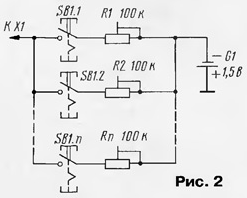Cable television network broadcast live programs not only the MB channels, but the cable sub-bands. A simple way of accepting them on old TVs says the author of a published article.
In recent years, homes in many areas of Moscow and other cities welcome TV broadcasting programs is conducted through the local cable network. Except broadcast-band MB sent via standard channels 1 - 12, there are many new TV shows in the bands of the so-called cable sub-bands. They are between 5 and 6, in the range of 110...174 MHz (the channels K1 - K8), and also between the channels 12 (MB) and 21 (UHF) in the intervals 230...294 MHz (channels K11 - K18) and 294...470 MHz (sub-band Hyperband channels K20 - C). The program was the result of converting signals transmitted via UHF channels, channels metre cable sub-bands. It due to the fact that many cable networks (with bandwidth up to 500 MHz) still not able to transmit signals at all frequencies UHF, although there are ultra-wideband cables (up to 1000 and 2500 MHz) and fiber-optic lines.
Standard channel selectors SC-M-24-2, SC-1, SC-M-15, etc., installed on your TVs the fourth, third and earlier generations (USCT, ZUSTST, OPENCT, ULPORT, etc.), do not allow programs that are in these the subbands. This is because the control voltage of the varactors these selectors can vary from +28...27...0,5 to 0,7 V. In order to obtain an opportunity of reception of these programmes, it is proposed to move the lower limit of the voltage control to zero and even small negative values. This makes it quite significantly extend the tuning range of such selectors in the direction of decreasing frequency due to the substantial increase in capacity varactors.
This shift provides the simplest console, the circuit is shown in Fig. 1. In simplified form, depicts the circuit of the channel selector (IC) and the device select programs (CIP). The numbering of parts in CIP is given for a standard unit USU-1-15. At the bottom, under the scheme, the position of the slider of the resistor settings R70 (bottom frequency sub-band) output voltage UVP can have a value within 0,5...1 V depending on the model CAA. To connect the attachment tension in point "A" decreases to zero and even slightly negative values, which depends on the position of the engine resistor configuration R1.

Therefore, tuned to the lowest frequency, for example, sub-band III (channels 6-12), or by setting the switch on the sixth channel (for OPCT) and connecting the console, you can receive television programs of cable TV in the interval between 5 and 6 MB.
The prefix can be performed in a separate unit, but it is possible elements to build into the TV. The length of connecting wires to the units (two of them) does not matter. The resistance of resistor R1 can configure to be in the range 22 to 100 ohms. It due to sudden changes in the capacitance of the varicap it is advisable to make two resistors with significantly ( tenfold) different values: one for coarse adjustment, the other (less par value) - multi-turn (e.g. C5-2) for precise.
To connect the console has been used a contact in the form of tubes made of sheet metal, bent in the diameter of the pins on the motherboard TV: the selector SC-M-24-2 - contact 4, for SC-D-24 - 5, SC-b-1 - 8, SC-M-15 - 5, i.e. contact settings for any other selector. The conductor from the common wire the console was supplied with connector "Crocodile". The switch SA1 is any. When the embedding of the elements of the STB to the TV wire coming from the switch can be soldered at the desired point. Do the same with the second wire.
Each time not to rebuild the resistor settings, you can enable multiple tuning circuits in parallel and enable the switch as it is shown in Fig. 2. The switch SB1 - P2K free button to turn off consoles or PG position for the same purpose.

The use of such prefixes allowed to take all 15 programs transferred cable network "Teleinform" in our area (Marino). The possibility of taking channels in the other sub-band in the restructuring of TV 21 channel UHF was not tested, as transmitted over the airwaves program already have been taken.
Author: N. Manaregen, Moscow






